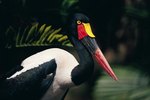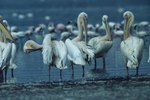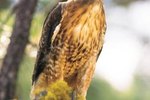
More than 700 cays, islands and islets make up the Commonwealth of the Bahamas. Located in the Atlantic Ocean, these islands are filled with lush landscape and surrounded by deep oceans. It's home to about 320 species of birds that survive in their natural habitat throughout the Bahamian islands.
Bahama Woodstar Hummingbird
Known as the smallest birds in the world, Bahama woodstar hummingbirds, grow to about 4 inches. Their common habitat includes pine forests, gardens, forest edges and clearings. They feed on small insects and nectar from flowers. Bahama woodstars are nonsociable and are aggressive toward other species of birds, frequently chasing other species away. They are capable of flying in all directions, including, backward and upside down. Female Bahama woodstars have white feathered throats, the males have violet colored feathers on their throat and forehead.
Bahama Parrot
Bahama parrots can be found in their natural habitat within pine tree forests and coppice forests. Their scientific name Amazana leucocephala bahamensis translates to "white headed amazon from the Bahamas." Their white feathered heads stand out against their green bodies and red feathers on their abdomen, cheek and throat. They regularly feed on seeds from pine trees, fruit from pond-top palm, poisonwood berries, pigeonberries and guava. Bahama parrots date back to more than 50,000 years ago, surviving during the Pleistocene era.
West Indian Whistling Duck
Eight species of whistling ducks are found in tropical regions worldwide. The west Indian whistling duck is the largest and most rare of the species, reaching heights of 22 inches. It is brown with a white throat, black streaks along the lower neck, red chest, white belly and long legs. They have a tracheal structure that allows them to produce a distinctive whistling call. The west Indian whistling duck is found in its natural habitat of swamps, mangroves, rice fields, palm savannas, lagoons and in sources of saltwater. They feed on rice, corn, seeds, wits, grasses and the fruit of the royal palm.
Bahama Swallow
The Bahama swallow can be found on the islands of Grand Bahama, Abaco and Andros. They can be seen throughout the other Bahamian islands during winter migration. Adults are 6 inches in length, have pointed wings, forked tails and slender bodies. Their colorful bodies have green on the upper part and white toward the lower half. Pine forests are their natural habitat. Insects are their main food source, meeting their nutritional needs. The Bahama swallow species only can be found within the Bahama Islands and are near-threatened to becoming extinct.
References
Resources
Photo Credits
-
Medioimages/Photodisc/Photodisc/Getty Images
Writer Bio
Based in Miami, Shellie Alyssa has been writing articles since 2011. Her articles have appeared on a variety of popular and informative pet websites including munch.zone. In 2000, she was awarded an editors choice award for Outstanding Achievement in Poetry from the International Library of Poetry. She holds a fashion merchandising diploma from Penn Foster College.




